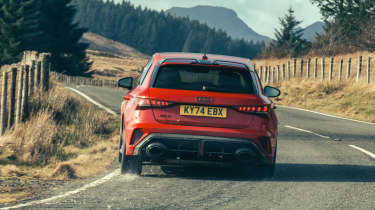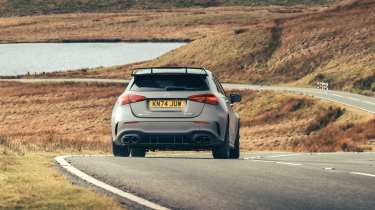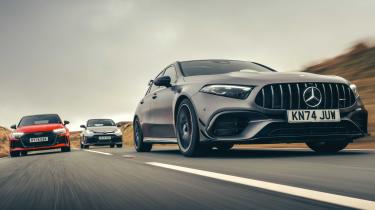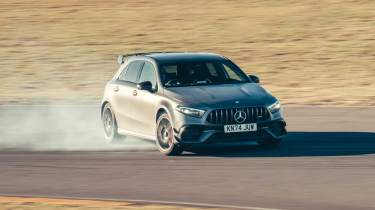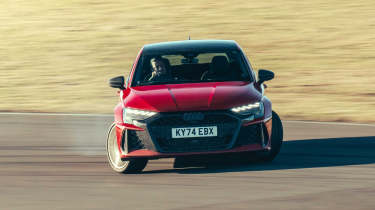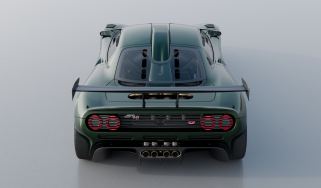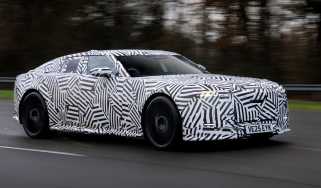Audi RS3 v Toyota GR Yaris v Mercedes-AMG A45 S – which is the best AWD hyper hatch?
We pit the Audi RS3 against the Toyota GR Yaris and the Mercedes-AMG A45 S in a battle of the AWD super hatches on the road and track. Which comes out on top?
Don’t wait up for me, I text photographer Aston Parrott, who’s arrived at our overnight stay just in time to grab dinner. I’m in a lay-by somewhere near the foothills of Snowdonia, at least an hour from the hotel with no signs of civilisation, listening to the throbbing, idling pulse of the Audi RS3’s five-pot. The last few miles have been intense, the Audi punching through the darkness and scrambling up the side of a mountain on this ragged, weather-beaten road. The inky black void over the edge suggests we’re now at quite a height.
There’s an eery silence as I switch off the engine and climb out to grab a few grainy snaps on my phone. It’s a view I suspect would be spectacular in daylight, and as my eyes adjust I can just make out the mass of mountains ahead, suggesting the topography will only get tougher and even more interesting from here. This is hot hatch country, and the RS3 is one of the most advanced and exciting of the breed. Tomorrow, it meets two of the others.
> Audi RS3 2025 review – can it topple AMG’s A45 S?
It feels like every time we bang on about the death of the petrol hot hatch, something new pops up to reignite our hopes of it living on just that little bit longer. Strictly speaking, neither the facelifted Audi RS3, nor the latest Mercedes-AMG A45 S nor the Gen 2 Toyota GR Yaris is entirely brand new, but each serves as evidence that there’s still an appetite for the breed, and a hunger to make them as extreme as possible. They also highlight the phenomenal complexity and engineering detail that underpins what used to be a class defined by primal, basic thrills. In the case of this trio, we’re talking about technology and performance that was once reserved for supersaloons, and supercars not long before that.
I know what you’re thinking. What about the Civic Type R, which we’ve previously crowned the best hot hatch on sale, perhaps of all time? Brilliant though the Civic is, it represents the ultimate evolution of the hot hatch as it’s always been known – four cylinders, front-drive, three pedals – and we wanted to explore the most advanced and radical interpretations of the concept, cars that challenge how a hot hatch should feel and perform. And they don’t come much more radical than these three.
More reviews
In-depth reviews
Reviews
The RS3 is familiar but fascinating. Not only is it the only hot hatch – the only new car, in fact – available with a five-cylinder engine, it will also be the last chance to experience Audi’s signature five-pot in a production car. It’s a stunning motor that’s dominated every model it’s been fitted to but hasn’t always found itself in a chassis to do it justice.
TT RSs, RS Q3s and older RS3s were big on sound and speed but short on interaction, but the current 8Y-gen RS3 found its feet with a genuinely exciting and adjustable chassis, made possible by Audi’s Torque Splitter rear differential. Though the four-wheel-drive system is limited to sending up to 50 per cent of its torque to the back axle, the Torque Splitter allows all of this to be directed to the outside rear wheel, making the car feel much more rear-driven at the limit. We lived with the pre-facelift model for six months in 2021 and it left a big impression. ‘Intriguing, characterful, useable and, at times, mind-bendingly ballistic,’ was our conclusion.
That’s broadly how I’d describe this one so far, too. On first acquaintance it’s docile and actually quite ordinary, with none of the sparkle you feel in your first few miles in a Civic Type R. But push some buttons (specifically the big red one marked ‘RS’ on the new, square steering wheel) and a wilder character emerges. The engine comes to life, the damping tightens up and the rear diff starts working more aggressively to keep you on your toes.
Fully unleashed, the RS3 is really exciting, with the brutality and muscle you’d expect of a fast Audi underlined with real edge and adjustability. On a damp, bumpy road you need to stay right on top of it, not just because of how quick it is, but because of how excitable the rear end can get as it skips across the surface and you learn to exploit that diff. It’s a very different thrill to the one you get from a traditional front-drive hatch, but a thrill it most definitely is.
John Barker has driven up in the A45, and Dickie Meaden in the Yaris. Neither is what you’d call totally enthused, with John lamenting the Merc’s lack of steering feel and Dickie not gelling with the Yaris’s gearbox – an eight-speed torque converter that’s a new option for the Gen 2 car. I swap into the A45, the closest in concept to the RS3, and head straight for a road that’s tailor-made for great hot hatches: well-sighted but single-track, winding its way through the hills with endless undulations and a surface scarred by low-hanging splitters.
How the A45’s M139 engine generates 415bhp from four cylinders without all of them going bang is one of life’s great wonders. It’s the most powerful pure-petrol hot hatch you can buy, with a 21bhp advantage over the RS3, but from where I’m sitting it doesn’t have the sheer guts and meaty mid-range of the Audi.
Only when you rev it out do the fireworks really start, which naturally means you start driving harder and flicking the paddles more often for it to come alive. This, and the fact the A45’s mass feels concentrated lower than the RS3’s, gives it a more racy feel. But I see what John means about the steering – it’s muted from the first turn of the wheel, and I find the rack a touch slow for some of the tighter sections up here.
I hadn’t bothered setting up the A45’s various modes before setting off, which was probably a mistake. There’s plenty to get your head around – too much while driving – and of the three cars it’s the most heavily digitised, with two screens bolted to the dash and another pair of round drive-mode displays hanging off the wheel. Press the Dynamic button on the centre console and options for the powertrain, damping, exhaust, ESC, transmission and AMG Dynamics appear, the last of which dictates the behaviour of the four-wheel-drive system.
> Mercedes-AMG A45 S 2025 review – the ultimate hyperhatch?
It’s similar to the RS3’s in that it can send 50 per cent of torque rearwards and split that across the back axle, but even in the most aggressive mode it still feels grippy and secure. In the RS3, Dynamic mode for the Torque Splitter helps rotate the car under light throttle openings, to the extent that it can counter-intuitively pick up a touch of understeer if you lift off, whereas the A45 has a more consistent balance. But if you commit hard and early to the throttle the Merc does pivot towards oversteer, which gradually builds from apex to exit.
Get it working in this zone and you can carry stunning speed in the A45. But there’s a bit of a mismatch between the parpy, frantic engine, the toughness of the damping (Sport is best to nail down the body but means you get thrown around in the seat on these roads) and the lack of connection and positivity from the steering. The brakes also have a disconcertingly long initial travel before they bite, although the grumble through the pedal suggests they might be past their best on this particular car.
It culminates in a hot hatch that wants to be driven hard and shows real ability, but doesn’t have the magnetism or approachability of the RS3. Dickie has a run in the Merc after me, and it leaves him cold: ‘It’s quite aloof in a way. It’s very effective and I respect what Mercedes has done with it, but it feels like a very Germanic exercise in what they can extract from that platform.’
When it comes to defying its humble origins, the GR Yaris is king. You have to assume that in a dwindling hot hatch market where low-margin superminis are being axed left, right and centre, Toyota probably didn’t expect to be producing a heavily revised GR Yaris five years on from when it first appeared. Yet here it is, streaked in road grime and giving much more powerful and expensive metal plenty to think about, as it always has.
Aston clangs the door shut and laughs at how cheap it feels, but as has always been the case with the GR, you sense the money has been spent on the important bits. For the Gen 2 that means a more powerful, 276bhp version of the three-cylinder engine (up 19bhp), a revised, stiffer chassis, Torsen diffs front and rear and, in this example, that eight-speed auto ’box.
Of the three it’s the easiest to build an instant connection with. It may carry advanced hardware but there’s an honest and robust feel to the way the Yaris goes about its business, with grumbly tones from the engine, heavy and communicative steering and a sense of solidity in the way it tackles bumps. Compared with the Audi and particularly the Mercedes, there’s less thinking to do and fewer layers to peel away to find the limit. That makes it less of a challenge, but it’s refreshing to be able to jump into a car and just get on with attacking a road.
I love the Yaris’s manual gearbox and, conceptually, it’s a better fit for the car. But I’m also finding plenty to like about the auto. The short ratios and seamless power delivery make the Yaris feel even more relentless, and comically easy to drive quickly. In manual mode there’s a slight delay to the shifts and they don’t bang home with the precision of the Audi or Merc’s DCTs, but with two hands always on the wheel you can focus on extracting the most from the car with minimal wastage, which plays into the Yaris’s giant-killing role. It just needs a big, tactile sequential shift lever in place of the generic parts-bin item, or a whacking great WRC-style two-way paddle fixed to the column. Probably something for the aftermarket to look into.
In this company the Yaris’s three-pot feels a bit flat after the initial surge of boost, but in real terms it doesn’t seem to matter, given how much confidence the car gives you to brake late, drive to the limit of the tyres and use the available road space. Driving the RS3 quickly can sometimes feel like you’re hanging on to it, but in the Yaris you’re very much dictating the state of play, bullying it through corners and chasing the throttle hard the moment you spot your exit. It just never seems to run out of control.
The sense of load through the chassis and steering, plus the fact that the four-wheel-drive system is set up to deliver pure traction rather than rear-end adjustability, means there are never any surprises. You can use the brakes to pin weight on the nose to get the rear moving but it barely requires correction, and even in the most rear-biased Track setting for the four-wheel drive, you slingshot out of corners with zero drama, every time. It’s a fantastically capable little car.
But we knew the Yaris was brilliant, and so far I’ve been most surprised by the RS3. Despite not being as consistent or authentic in how it drives, at times it delivers peaks of excitement that not even the more nailed-down Toyota can match. ‘The best bit about the Audi is its engine,’ says John. ‘Dynamically, it has better steering and rides more effectively than the Merc but it can feel a bit too taut, the back end kicking over mid-corner crests. There’s a sense this car’s sticky Pirelli P Zero Rs add to that sensation.’
For the money – £60k – you’d expect it to offer something special. And though it does in the way it drives, the RS3 doesn’t feel particularly expensive inside. Aside from the dimpled square wheel there isn’t a whole lot to suggest you’re in Audi’s ultimate hatch, and the swathes of black plastic aren’t very inspiring. The optional carbon bucket seats would lift the cabin but also the price, by a further £2.5k.
The Merc is even more expensive at £63k before options, and with its aero kit, faux centre-lock wheels and racier standard seats it does make more of an effort to justify that. The detailing isn’t to all tastes, though, including the flashy graphics on the displays and the naff black stripes on the dash. John reckons he could achieve similar results with some gaffer tape and scissors.
The Yaris feels much cheaper than both because it is (£45,750 for the automatic version). The materials are plain and robust and the Gen 2 car’s new dash looks terrible and pleasingly retro JDM at the same time. I think I’m a fan. The seating position is markedly improved over the original car’s, too, set lower with a clearer sight-line between the dash and rear-view mirror. Being a three-door it’s much less useable than the two five-doors, but also more compact and lighter on its feet, which you really notice on these roads. At 1300kg it’s 265kg lighter than the Audi, and 305kg lighter than the A45.
Would the German duo be better off with some of their complexity (and therefore weight) stripped out? I’m not so sure. In both cases, the sophisticated four-wheel-drive hardware and various modes make them infinitely more entertaining than previous models that did without the latter. Similarly, the Yaris’s indomitable character is intrinsically tied to its permanent, variable four-wheel-drive system and power-dense turbocharged engine. To go down the route of simplicity and purity would be to completely rethink the nature of all three cars, at which point you might as well just buy a Civic Type R.
After a fantastic, committed drive in the Yaris, I’m drawn back to the A45 to see if it comes together on a smoother stretch with more space to play with, and low-speed corners to dig into its balance. It does to an extent, particularly as you put higher loads through the chassis and lean on its support, rather than trying to judge the available grip through the wheel.
Once you start trusting it you can add more aggression to your driving and the A45 gives you more options. Turn in hard on the brakes and there’s a sense of mobility at the rear, and with the revs up high you can carry this attitude through as you jump back on the power, straighten the wheel and fire onto the next straight.
Suddenly you realise how the A45 wants to behave and how rewarding it can be – it just takes a bit more time to get there. The RS3, on the other hand, gives up instant rewards through the might and sound of its engine, which never gets old, and a chassis that’s more compliant than the Merc’s but still expressive.
Knock the dampers back to Comfort and you can almost live out your Group B Quattro fantasies, feeling the body shift around and the rear squatting under power as you scramble out of corners at full noise. It doesn’t feel like a typical hot hatch, but there are layers and a sense of exoticism that keep you coming back.
The Yaris behaves in the most conventional way, but it’s able to do quite extraordinary things. Few cars at any price are as approachable or immediately exploitable, and of the three, it’s the one that consistently gets the best out of the conditions you throw at it. It makes the RS3 feel big and a bit loose, and the Mercedes detached and synthetic.
So it boils down to whether the Yaris’s sense of connection, control and sky-high limits are enough to keep you engaged, and whether you can pass up on the magic moments the less finely honed RS3 can deliver. It’s not an easy call, and there are times when you wish the Yaris would loosen its reins and bite you for taking such absurd liberties with it. But it’s objectively the best road car here, and no other hot hatch feels so tailor-made for the rough and tumble of these roads. And now over to Dickie to find out whether it can deliver the same killer blow on track…
All-wheel drive hot hatch: track test
The roads of Snowdonia paint a detailed picture of our trio’s relative characters and capabilities, but the speed and wide open space of the Ty Croes circuit afford us the freedom to push hard enough to explore the outer limits of their performance and handling.
We’re not taking lap times to find a finishing order. There’s little point when the most potent car has a 50 per cent horsepower advantage over the least powerful. Instead we want to discover whether their most aggressive, least restrictive dynamic modes unlock an extra level of ability and enjoyment. Oh, and have some fun on the way.
If you’ve just read Yousuf’s account of how we got on with this trio on the road you’ll know I struggled to gel with the A45 S. It’s an astonishing package, all that power (415bhp!) extracted from a 2-litre four and deployed via a clever all-wheel-drive system. And yet, no matter what mode, road or mood, I found it hard to make a true connection.
My main beef was the steering feel. Or rather the lack of it. There just isn’t much in the way of on-centre feel. The car also corners very flat, so whether you guide, point or bung it into a corner there’s little to tell you how much grip the road has to give or how hard you’re working the car.
It’s a very different animal here. The most aggressive dynamic modes added some edge and attitude on the road, but they really transform the A45 S on track. A lot of this is due to the fact that instead of working in that zone where feel is paramount, a track allows you to commit to working at or beyond the limit of the tyre with no need to feel your way towards it as you do on the road.
There’s a Drift mode, but you don’t need to activate it to bring the AMG alive. One step back from that is optimum, but it requires you to work your way through a swathe of choices with names like Pro, Master and Obi Wan. I might have made the last one up, but you get the gist.
The track also allows you to spend more time in the engine’s sweet-spot, which is higher up the rev-range than you might expect. The sound is highly synthesised – think Assetto Corsa through a good set of speakers – with lots of theatrical pops, bangs and farts on up- and downshifts. It’s fun, but perhaps a bit juvenile for a £60k-plus car.
Driven with a modicum of restraint, the A45 S feels pointy and agile, with a four-square balance that will push into natural-feeling oversteer under power if you time the torque swell nicely. There’s definitely a knack to it, though. Learn how to get the front end loaded and it will pivot into the turn before rotating into a smooth arc of power oversteer. Timing is all, however. If you haven’t quite carried enough momentum, or you fail to ride that wave of torque with sufficient finesse to get it flowing to the rear axle, the A45 S will transition into stubborn and quite extreme understeer.
It’s a bit bemusing when it does it, especially as it feels so right when you nail it. Rough-housing it works to a degree, but you know you’re fighting the chassis and transmission’s natural inclinations. Better to be clean and committed and let the car do more of the work.
It also pays to remember that the AMG weighs 1600kg when you’re throwing it around. Not because the brakes can’t cope – they do, admirably – but because it eats tyres like I eat chocolate Hobnobs. Most notably the outside front, which suggests that even when it’s not smokin’ like John Rhodes is driving (look him up, kids) the A45 is working its front end harder than you think.
The RS3 is a much warmer character on the road, largely thanks to the fabulous five-cylinder engine that snorts and howls and warbles like an echo of Audi’s Group B and IMSA glory days. It’s not just that engine, though. There’s something more stimulating about the way the RS3 steers and handles. It’s more boisterous by nature, so despite having welcome pliancy compared with the crashy Merc, it also fights the road a little, tugging from the front like a front-driver and skipping at the rear when you really get it working hard under power.
Unlike the AMG, which genuinely comes alive on track, the Audi gives more of the same. A lot more when you dig into the dynamic modes and explore the settings for the natty Torque Splitter, which works in a similar way to the Merc’s AWD in that it can direct all of the torque that’s sent rearwards (up to 50 per cent) to the outside wheel.
The first time you chuck the RS3 into a corner like you mean it is one of the stranger experiences you’ll have. A thrill for sure, but those suggestions of a split personality on the road are magnified when working the tyres and all-wheel-drive system to their limits.
Generally, the RS3 points into every corner like a very grippy front-drive car. It feels absolutely nailed – as you’d expect given that the front track is wider than the rear (as are the tyres) for a full English Bulldog stance – but with a slightly flighty rear. It’s not loose exactly, but it pings my front-drive radar, much as my old Renault Sport Mégane Trophy used to when it was on cold tyres.
The challenge comes in decoupling some of your front-drive on-limit muscle memory, and instead treating the RS3’s handling like a mash-up of aggressive front-wheel drive and progressive rear-wheel drive. It’s a stimulating exercise, using a throttle lift on the way in to get the tail moving, then picking up the power as you would in a rear-drive car and using your right foot and the steering wheel to balance the ensuing slide.
> Toyota GR Yaris 2025 review – the modern homologation special gets even better
It’s more sustainable than in the Merc, partly because the all-wheel-drive system seems happier to do it and also because the five-cylinder engine has more torque lower down the rev-range. Peak torque is the same 369lb ft in both cars, but the Audi’s arrives at 2250rpm and holds until 5600 while the Merc’s hits at 5000 and has shot its bolt by 5250. All of which means you can take a higher gear in the Audi and ride the building swell of shove. It’s a more exciting car as a result, but much like the Merc it devours its tyres when you start to enjoy the most extreme driving modes. This said, the RS3 gets brownie points for stripping its outside rear of tread rather than its front. It’s the little things.
After the endless menu-scrolling, button-pushing and finagling required to unlock the Merc and Audi’s ‘cheat modes’ it’s refreshing to jump into the Toyota and just have a simple knob to twiddle and basic ESC to disable. It’s like stepping back into the noughties.
Of our three protagonists, the GR Yaris is the most straightforward in terms of hardware (and software) and is the easiest to get to know as a consequence. This what-you-see-is-what-you-get disposition makes it a brilliant partner on the road. Consistent, transparent and forgiving, its character is less contrived and more constant. You work with what you’ve got rather than feel compelled to fiddle with it, and the resulting partnership means you form a closer, less conditional bond with the machine.
Of our battling trio, you’re more likely to see a Yaris on a trackday than either the Merc or the Audi. I suspect that’s partly due to the relative affordability of the Gen 1 GRs (the Gen 2 is around £15k more), and also because plenty of them had remaps and suspension work done by their enthusiastic owners. This Gen 2 car is arguably more track-focused because of its paddleshift eight-speed transmission, though it took me a long time, right until the end of the test in fact, before I began to warm to the auto ’box. Eventually I came to enjoy it despite the slightly soft-edged shifts, but I wouldn’t choose it over the manual. It just doesn’t seem to suit the package, though perhaps that’s because I find the GR so reminiscent of old Imprezas and Evos.
It certainly changes the way you drive the Yaris, both on road and track. Without the need to divide your hand-eye co-ordination between steering, clutch and brakes, you are free to run deeper and harder into turns, downshifting later than you would with a manual. That said, I find it detracts from fast road driving because it’s satisfying to operate more aspects of the machine while matching your speed and line to the unfolding, ever-changing road. On a circuit, however, where consistency and repetition drive your inputs, the paddleshift ’box comes into its own.
Unsurprisingly the Yaris doesn’t feel especially quick after the Merc and Audi, but it makes the most of its 276bhp, the gruff three-cylinder engine working hard through the mid-range and spinning ever-so-slightly more freely at the top end than did its predecessor.
The Yaris is light, too, a good 300kg lighter than the Merc, though you tend to feel the benefit of this more when it comes to stopping and turning as the A45 S has 415 reasons why it mitigates its mass in a straight line. Ironically the Yaris feels the heaviest thanks to weighty steering that’s more physical than that of both the Audi and AMG.
Settings-wise, the little Toyota has plain and descriptive Normal, Gravel or Track modes to adjust the all-wheel-drive system, and Normal, Sport and Eco for the throttle response and shift characteristics. As you’d imagine, Sport is the go-to setting for the latter, as it serves to inject the Yaris with a shot of espresso, giving the throttle and gearbox some welcome snap and the steering a bit more heft.
> Is this mid-engined Toyota GR Yaris a 2027 MR2 test car?
Switching between the AWD modes isn’t as transformative as you might expect given it takes you from a 60:40 torque split front-to-rear in Normal to up to 30:70 in Track mode. Yes, you can feel the difference, and yes the Yaris can be thrown into some interesting shapes (more on the way into a corner than the way out), but it doesn’t go to anywhere near the extremes of the German pair. No matter how hard Yousuf, JB or I tried to give it the full Rovanperä, the best we could muster was some lift-off oversteer on the way in, followed by a brief moment of power oversteer. Then the Yaris would square itself up and pull into a neutral-to-understeer trajectory.
Tyres are a factor here. The Yaris is on relatively mild-mannered Michelin Pilot Sport 4 Ss whereas the RS3 is on ultra-aggressive Pirelli P Zero Rs (the A45 has Continental SportContact 6s). It might seem counter-intuitive to feel that a lack of grip is the issue, but because the inherently nose-led Yaris doesn’t find the same bite on turn-in, you can’t rotate it into the corner fiercely enough to destabilise the rear. It’s also 81lb ft down on torque compared with either of the German cars, which makes it hard to sustain any slide that you do manage to provoke.
On the face of it that’s not a great showing for the Toyota at Anglesey. It’s certainly not the most fun – that accolade goes to the rowdy Audi. Nor is it the most different from road to track – that’s the Merc. What the Yaris’s track showing illustrates – beautifully, as it happens – is that the little Toyota gives its all on the road and leaves so little in reserve as makes no difference. Paradoxically, the Audi and AMG have more performance than you can reasonably access on the road, plus transformative dynamic modes that go to real extremes. Yet neither is naturally suited to track-work. Go figure.
This feature first appeared in evo 332. You can still pick up a copy of the magazine online via the evo shop.

